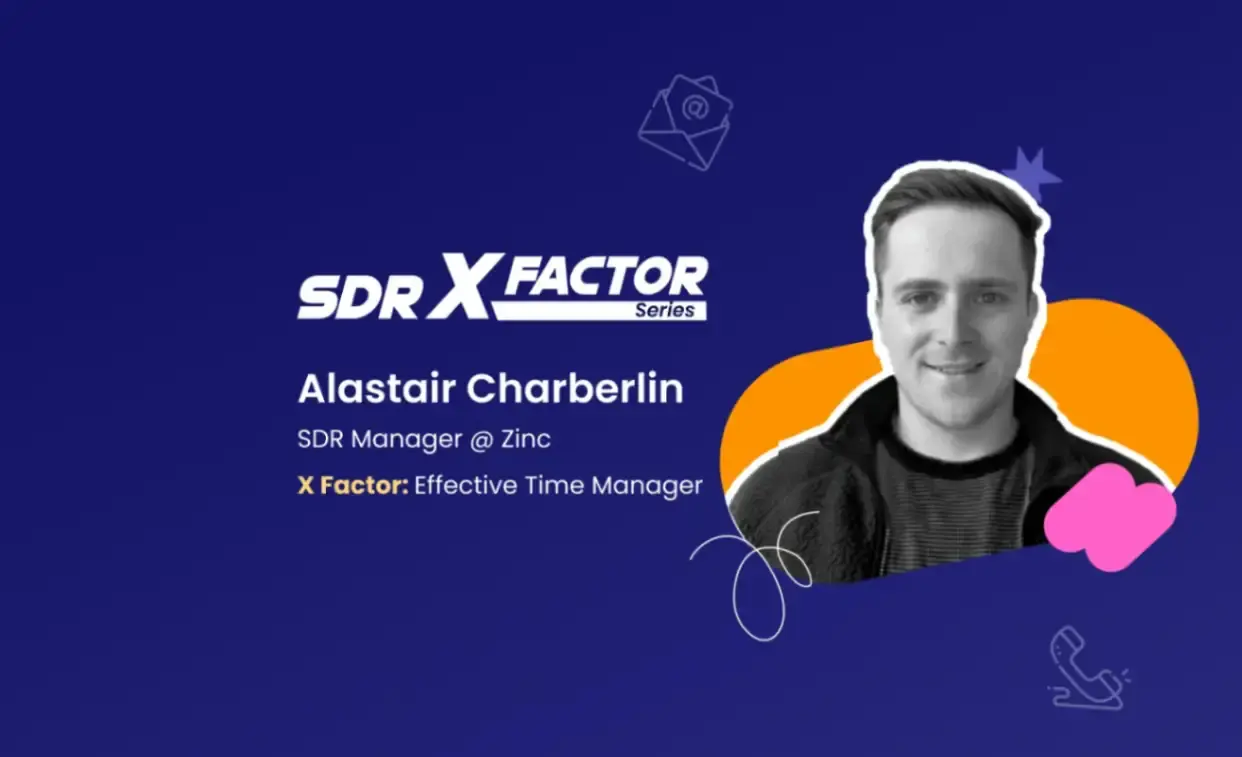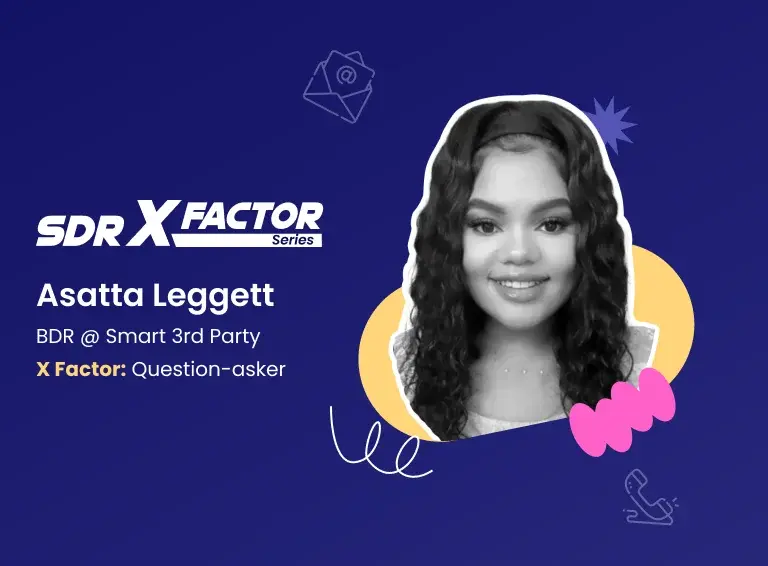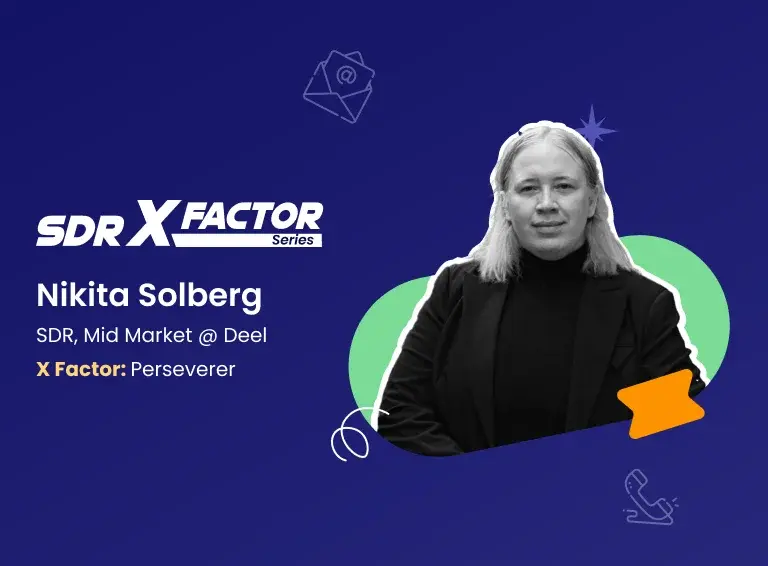The SDR X Factor is a series of long-form stories that aims to reveal what sets top-performing sales reps apart. How do they go about their day? What do their cold calling and cold emailing strategies look like? How are they crushing quota every time? We extract their key strategies, tips and tricks so you can sell better.
For the sixth part of this interview series, we’re joined by Alastair Chamberlin, Sales Development Representative (SDR) Manager at Zinc, an employment background checking software company based in London. Before joining Zinc, he was the Team Lead, Enterprise SDR at Chili Piper for over a year. Overall, he has over 6 years of experience in various sales roles in his career.
We spoke to him to find out his approach to outbound outreach, particularly cold calling and cold emailing. From his rich experience in sales, he provided valuable and actionable insights for SDRs, which we have compiled below.
1. From E-Commerce To Managing Sales Reps

Alastair started his career in an e-commerce company, where he worked for around 3 years. “I kind of fell into it. A friend was a recruiter, and she had the job on,” he recalls.
Next, he made the transition to SaaS and worked as an SDR in two firms, before joining Chili Piper in their Sales Development team.
- As the Team Lead, Enterprise SDR at Chili Piper, he generated a pipeline of $315,000 and set a company record of pipeline generated in a single month.
- During his stint, he onboarded 3 SDRs, and his Enterprise SDR team managed to regularly hit their quota of booking 5 qualified meetings every month.
Right now at Zinc, he is building his team and the processes. “At the moment, I'm just observing and trying to understand what's currently happening today, and where we can make the biggest impact as quickly as possible,” he says.
i) What Sets Him Apart?
- Always ensures the product fits his prospect’s needs
One of the first things he rectified early on in his career is to always ensure through good research that his solution he is selling fits the needs of his prospects and solves their pain points. He won’t force his solution on a prospect with no use-case match as opposed to blindly selling to the prospect without doing adequate research.
Through this, he not only has more productive conversations instead of just spraying and praying, but he also earns the prospect’s goodwill as they feel that he isn’t wasting their time. “You want to be respectful of people's time. If it's not a good fit for them, there's no point in having a conversation. I think that the key thing is identifying early on, like, if it's a good fit, and if it's gonna be valuable to them,” he elaborates.
- Manages his time through time blocks
As SDR Manager, Alastair not only needs to manage his time effectively, but also his team’s time. He does so by creating time blocks for all of his teammates’ tasks.. “My present SDRs are covering the whole world as an enterprise team. So, it isn't stuck to one particular time zone. You really had to plan out when you were going to do outreach to different parts of the world,” he explains on the need for time management.
He uses KosmoTime to add time blocks for these tasks. "And then if you don't get them completed, they roll into your next time block. So I found that quite helpful for doing tasks that weren't necessarily part of my day-to-day," he adds.
2. How Alastair Pulls off Cold Calls
Alastair decides the number of cold calls to make in a day based on the conversion rates. Based on the conversion percentage for a given week or month, he would make anywhere between 30 calls a day to even 100 calls a day. His benchmark is 20 cold calls per day.
In his long experience as a salesperson, he has evolved a commonsensical approach to cold calling without overcomplicating things to increase the chances of booking meetings. Here are a few glimpses from his cold calling process:

i) Prefers to Cold Call Throughout the Day
Instead of cold calling only within a set time block, Alastair prefers to spread his cold calling throughout his working hours to maximize the chances of booking meetings. “It's a game of luck. You are hoping the person's gonna pick up the phone, and they're not busy. So doing it throughout the day, I've just found more success with it,” he explains.
In addition to improving your chances to book more meetings, spreading the cold calls throughout the day would also generate useful data that you can use to analyze your calls and improve your process. For example, if you want to know the best time to cold call your prospects, you'll know it only if you have called throughout the day at least a few times. This way, you'll have enough data to identify patterns and decide which the best time to call is.
ii) Studies the 10-K Report of Prospect’s Company for Research
Public companies file a document known as a 10-K report every year with the U.S. Securities and Exchange Commission that is available in the public domain. This would contain crucial details about the company’s financial performance, mergers and acquisitions, risks, deals, etc.
For SDRs, 10-K reports would be an excellent resource to do research and understand the prospect's company. Alastair notes that studying 10-K reports comes in handy for Enterprise SDR teams especially because they’d mostly reach out to C-suite executives. These reports would reveal 3 crucial details about the company:
- What are the goals of the company?
- What do they care about?
- What is their main focus for the year ahead?
In addition to this, he also does the usual research on the prospect through LinkedIn to learn about their role, location, responsibilities, who they report to, and other members in their team. The aim of all this research is to be sure about the prospect’s pain points, and that your solution aligns with their company goals, he stresses.
⚡ Resource: Type in the prospect's company name here to access their 10-K report.
iii) Always Gives the Reason for His Call
Alastair opens a cold call with this line: “Hello, I know you weren't expecting my call. But if you've got a minute, I can tell you why I'm calling. And then, we can decide if it makes sense for us to continue the conversation.” After this, he pauses for their reply.
As he doesn’t use scripts for his cold calls, he sticks to this opener and steers the conversation based on the prospect’s reply. Usually, they’d be curious why he called after hearing this opener.
iv) Handles Objections by Focusing on Pain Points
When it comes to handling objections, Alastair would always stay focused on the prospect’s pain points, instead of stressing on his product’s features. Telling how other customers, who were facing similar pain points switched to his product from a competitor’s, is a strategy that has often worked in his favor.
“It’s just relaying what we've seen in the market, and what we've seen from our current customers, where they've come from. And then just kind of explaining the story around it,” he elaborates. Here’s how he does it:
a) Objection: “We’re Using a Competitor’s Tool.”
When faced with this objection, he would first tell the prospect that the tool they’re using is a good one, instead of dismissing it, which could annoy them. “Yeah, I’m familiar with them. Really good tool for scaling businesses,” would be his typical opening line for this objection.
Next, he would go on to tell how some of his existing customers switched from the tool they were using to his product, something on the lines of:
"Typically, we found that our customers that have come from there have found that once they switch, they've seen real value in our enhanced features."
After this, he would pick a specific pain point and explain how his product would solve better than the competing tools, usually with the help of case studies. “If you can share a case study to back up what you're saying, I think it’s pretty good. And this worked for me in the past quite a few times.”
b) Objection: “I’m Not the Right Person.”
For this objection, solid research about the prospect could come in handy. Once the person says they’re not the prospect he was looking to speak to, he would name-drop some of the prospect’s team members or their manager, asking whether it was this particular person that he should reach. “They sometimes will be a bit more conversational with you if you've done that legwork upfront,” he says.
v) Networks With Gatekeepers if They’re the End Users
Handling gatekeepers is a tricky business, Alastair admits. He tends to avoid them altogether by focusing on direct dials to prospects and decision makers.
However, he recalled that earlier in his career as an SDR in the travel industry, he networked with gatekeepers—mostly executive assistants and personal assistants—as they were responsible for scheduling the travels of the decision makers. “At the end of the day, they were going to be the person using any tool that was brought on board. They were the end user. So, it made sense to actually speak with the gatekeepers,” he says.
So, how to talk to gatekeepers? “You can just ask them what their role is in the business, what they're responsible for, and just kind of let them talk about it from there,” he suggests. Once you get them talking, you could ask about the information you’re looking for.
vi) Builds Rapport by Being Genuinely Conversational
Alastair believes that there’s no set way to build rapport with prospects. However, he does believe that being friendly, honest and displaying integrity are key ingredients for rapport building.
“I think if you're conversational, and you have a genuine conversation with someone about anything, I think you can build rapport through that,” he says. Also, he’s not a fan of small talk, and has found more success in building rapport by getting straight to the point about how his product would be a good fit for the prospect.
vii) Alastair’s Tips From His Successful Cold Calling Journey
a) Don’t Overcomplicate Things While Researching
Many SDRs would find themselves falling into rabbit holes while researching prospects, knowing details that have no use to the actual outreach. To help you stay focused, Alastair recommends first looking into the goals of the prospect’s company, and how your product ties into their goals.
“And that's more powerful than knowing where they went to school or what sport they'd often play,” he adds. Such trivia can be handy, but you have to couple that with learning about the company’s goals and product fit to have a successful outreach.
b) Maintain a Hit List of Your Prospects
Alastair says he maintains a “hit list” of prospects on his desk, which was the list of people that had engaged with him, replied to him, and told him to follow up at a later time. “Updating that is like priority number one, because it set out what I was doing for the day and what I was focusing on,” he says.
3. How Alastair Keeps His Cold Emails Relevant With Minimal Personalization

“For me, relevancy is probably more important than personalization, more scalable as well.”
This is the motto of Alastair’s cold emailing process. He sends anywhere between 100 and 150 cold emails in a day using his sales engagement tool, which includes automated and one-off emails.
But he likes to keep his personalization minimal—a strategy that enables him to personalize at scale.
How does he make this approach to cold emailing work? Let’s take a look:
i) Keeps His Personalization Role-Specific
Alastair doesn’t prefer hyper personalization for his cold emails as it isn’t scalable. “I think if you just rely on personalization alone, it's risky,” he warns. Given that he has cadences for different buyer personas, he sticks only to the bare essentials to keep his personalization role-specific.
Before starting to send the cold emails, he’d fill out custom fields for account-level personalization in his sales engagement tool, such as the prospect’s name, their company name, their role, and competitors. “All of that information was being populated in our emails, and then we will add the stuff on the person as we wish,” he adds.
Even when he comes across an interesting detail of a prospect, such as their favorite sport, he’d tie it to the product to keep it relevant. An example he gives is how he personalized an email to a C-suite executive, who was into rugby as evident from his LinkedIn posts.
"I wrote an analogy about how converting a try in a game of rugby is like the difference between winning or losing, and the same applies to their inbound leads."
Minutes after he sent this email, the executive replied, and he managed to book the meeting.
ii) Experiments With Different Types of Personalization Methods
Alastair doesn’t restrict himself to just one kind of personalization method, whether it’s attaching images, GIFs, or videos. He uses different methods for different stages in his cadences.
For one stage, he’d create a GIF of how his tool works and attach it with the email. He’s also experimented with image personalization by attaching funny memes towards the end of the cadence, when the prospect hasn’t replied to the previous mails. And sometimes, while doing outreach on LinkedIn, he sends voice notes, which has proven successful in getting replies.
iii) Prefers Using Emojis in Subject Lines
Like many SDRs, Alastair too prefers keeping his subject lines short, by keeping it to a maximum of 3 to 4 words.
He’s also a fan of using emojis in subject lines, wherever it’s appropriate. “I didn't see it damaging anything. I just thought it lightened it up a bit,” he remarks.
iv) Uses Email Clustering To Boost Reply Rates
To improve the chances of prospects replying to his emails, Alastair uses the email clustering technique, which involves sending 3 short emails back-to-back to form a cluster. He would then send a bump email to move this cluster of emails to the top of the inbox, making it more visible to the prospect.
“We used to do 3 clusters,” he says. This way, each prospect would receive around 10 emails in the cadence.
Mostly, each of the emails would be only 50 words long. Out of these 3 clusters, which will be sent with gaps in between, the first cluster generally gets the maximum number of replies from the prospects. “The bump email would normally get a decent amount of replies,” he says.
v) Uses 1-2-3 Email Instead of Breakup Emails
Alastair doesn’t send breakup emails at the end of the email cadence if the prospect hasn’t replied to his previous emails. “I still wanted to carry on reaching out to people. I wasn't gonna close the file, so to speak,” he says.
Instead, he sends what’s known as the 1-2-3 email. Here, he lists out 3 options and asks the prospects to just reply with number 1 or 2 or 3. The options would usually be:
- Are you interested?
- Do you want me to stop emailing?
- I'm interested, but the time is not right.
This usually gets replies from the prospects, he adds. If a prospect doesn’t reply, he would first check whether they have opened his emails using his sales engagement tool, and then check if he needs to tweak his outreach process. “Maybe we could do some direct mail or maybe we could reach out on LinkedIn. I just review the channels we've used and then go again.”
4. Tête-à-Tête With Alastair

i) One Thing That You Will Not Compromise on When It Comes to Work-Life Balance?
“Making sure to take time off. It's easy to get burnt out as an SDR.”
ii) Any Favorite Books That Helped You as an SDR?
“Atomic Habits is a good one. And Fanatical Prospecting.”
iii) Who Do You Follow on LinkedIn for Sales Tips?
“Kyle Coleman, Justin Michael, and JB Sales.”
iv) What Would You Do if a Prospect Contacts You After Your Work Hours or During the Weekend?
“If it’s on the weekend, I just reply on Monday. If it's in the evening, then I'll book the meeting.”
v) What Would You Do To Unwind Yourself After Work?
“I play a lot of sports. I do training and in the evenings for rugby and going to the gym.”
vi) Best Sales Advice You’ve Ever Received?
“If you did the input, the output would eventually follow. You just have to trust in what you are doing, follow the process, and just not give up.”
Interviewed and written by: Akileish R.





